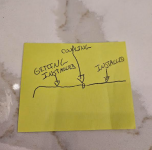Alwayslearningelec
Senior Member
- Location
- NJ
- Occupation
- Estimator
Like to know, from estimating standpoint, if my assumption on # of cut/thread required seems about right? Obviously you can not always be 100% accurate...hence estimating.
1. 150' run from a panel to a panel. with a pull box in the middle. Bends and not factory elbows. If starting you run at the panel would not need and cut/thread there. At one side of the pull box I would figures a cut/thread as don't know if box will be right at full stick. WOuld not figure a cut/thread on other side of box as would start a full length there. Would figure a cut/thread where ending at the panel as may not end with full stick. So two cut/ threads/ Make sense?
2. 150' run from panel to panel with one C conduit body and 2 factory elbows. Same as above for starting and ending at panel. Would figure a cut and thread at one side of the conduit body and factory elbows. Make sense?
1. 150' run from a panel to a panel. with a pull box in the middle. Bends and not factory elbows. If starting you run at the panel would not need and cut/thread there. At one side of the pull box I would figures a cut/thread as don't know if box will be right at full stick. WOuld not figure a cut/thread on other side of box as would start a full length there. Would figure a cut/thread where ending at the panel as may not end with full stick. So two cut/ threads/ Make sense?
2. 150' run from panel to panel with one C conduit body and 2 factory elbows. Same as above for starting and ending at panel. Would figure a cut and thread at one side of the conduit body and factory elbows. Make sense?

